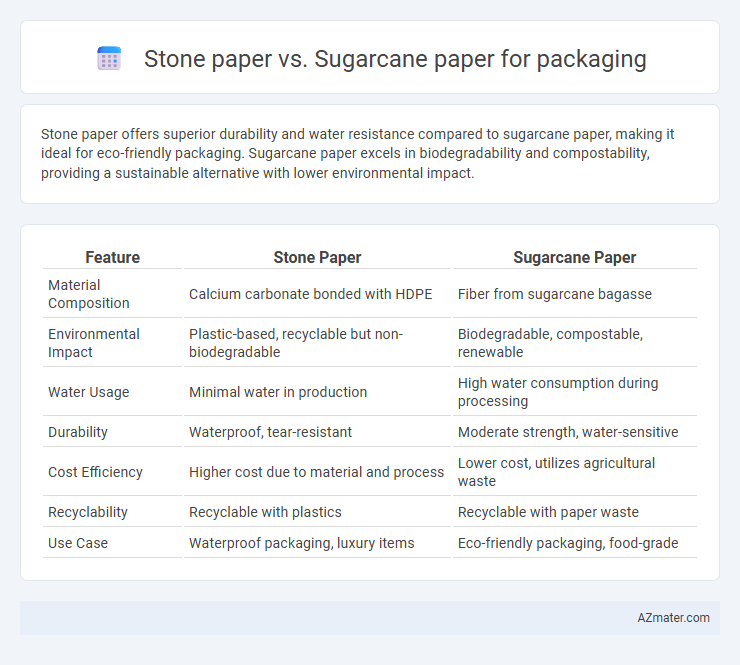Stone paper offers superior durability and water resistance compared to sugarcane paper, making it ideal for eco-friendly packaging. Sugarcane paper excels in biodegradability and compostability, providing a sustainable alternative with lower environmental impact.
Table of Comparison
| Feature | Stone Paper | Sugarcane Paper |
|---|---|---|
| Material Composition | Calcium carbonate bonded with HDPE | Fiber from sugarcane bagasse |
| Environmental Impact | Plastic-based, recyclable but non-biodegradable | Biodegradable, compostable, renewable |
| Water Usage | Minimal water in production | High water consumption during processing |
| Durability | Waterproof, tear-resistant | Moderate strength, water-sensitive |
| Cost Efficiency | Higher cost due to material and process | Lower cost, utilizes agricultural waste |
| Recyclability | Recyclable with plastics | Recyclable with paper waste |
| Use Case | Waterproof packaging, luxury items | Eco-friendly packaging, food-grade |
Introduction to Stone Paper and Sugarcane Paper
Stone paper is a sustainable alternative made primarily from calcium carbonate bonded with non-toxic resin, offering water resistance, durability, and eco-friendly production without relying on wood pulp. Sugarcane paper, derived from the bagasse fiber left after extracting juice from sugarcane, provides a renewable and biodegradable option that reduces agricultural waste and deforestation. Both materials are innovative substitutes for traditional paper, promoting environmental sustainability in packaging applications.
Raw Material Sources and Sustainability
Stone paper, made primarily from calcium carbonate and a small percentage of non-toxic resin, utilizes abundant mineral resources, reducing reliance on wood pulp and water-intensive processes. Sugarcane paper is derived from bagasse, the fibrous residue left after extracting juice from sugarcane, promoting agricultural waste valorization and reducing landfill impact. Both materials offer sustainable alternatives to traditional paper by minimizing deforestation, but sugarcane paper leverages renewable biomass while stone paper emphasizes mineral-based resources with longer durability and water resistance.
Manufacturing Processes Compared
Stone paper manufacturing involves crushing limestone into fine powder and mixing it with non-toxic resin, creating a durable, waterproof sheet without using water or trees, resulting in a low-emission process. Sugarcane paper production utilizes bagasse, the fibrous residue from sugarcane stalks after juice extraction, which is pulped and processed similarly to traditional wood paper but requires water and chemical treatments. The stone paper process reduces water consumption and chemical use significantly compared to sugarcane paper, offering a more sustainable packaging option with lower environmental impact during manufacturing.
Environmental Impact Analysis
Stone paper, made from calcium carbonate and resin, significantly reduces deforestation and water consumption compared to traditional sugarcane paper derived from bagasse fibers. While sugarcane paper is biodegradable and compostable, stone paper boasts waterproof and tear-resistant properties, extending its usability but presenting challenges in recycling due to its plastic resin content. Life cycle assessments indicate sugarcane paper has lower carbon emissions during production, whereas stone paper offers durability benefits that reduce the frequency of replacement, influencing overall environmental impact.
Strength and Durability in Packaging
Stone paper exhibits exceptional strength and durability due to its mineral-based composition, offering high tear resistance and water-proof qualities ideal for robust packaging needs. Sugarcane paper, derived from agricultural waste fibers, provides moderate tensile strength but may lack the water resistance required for heavy-duty packaging applications. Comparing both, stone paper outperforms sugarcane paper in packaging strength and durability, making it suitable for environments demanding long-lasting protection.
Printability and Aesthetic Qualities
Stone paper offers superior printability with its smooth, non-porous surface ensuring vibrant, sharp images and consistent ink absorption, ideal for high-quality packaging designs. Sugarcane paper, derived from agricultural waste, provides a natural texture that enhances rustic and eco-friendly aesthetics, though its porous surface may lead to slightly blurred or less vivid prints. Both materials excel in sustainability, but stone paper's brightness and durability make it preferable for premium packaging requiring detailed graphics and long-lasting visual appeal.
Cost-Effectiveness and Market Pricing
Stone paper offers higher initial production costs due to specialized raw materials like calcium carbonate, yet its durability and water resistance can reduce packaging replacement expenses, enhancing overall cost-effectiveness. Sugarcane paper utilizes agricultural waste, making it more affordable and environmentally sustainable, which drives competitive market pricing favored by eco-conscious brands. Market trends indicate growing demand for sugarcane paper as it balances cost savings with sustainability, while stone paper targets premium segments valuing longevity and moisture resistance.
Water and Energy Consumption
Stone paper manufacturing consumes approximately 60% less water than sugarcane paper production, significantly reducing its environmental impact. Energy consumption during stone paper production is also lower due to the absence of pulping and bleaching processes required in sugarcane paper manufacturing. Consequently, stone paper offers a more sustainable option for packaging by minimizing both water usage and energy demands.
Biodegradability and End-of-Life Disposal
Stone paper offers superior resistance to water and tearing but has limited biodegradability, often taking decades to break down in natural environments, making recycling or landfilling the primary disposal methods. Sugarcane paper, derived from agricultural waste and composed of cellulose fibers, biodegrades rapidly within months under composting conditions, providing an eco-friendly end-of-life solution. Choosing sugarcane paper over stone paper enhances packaging sustainability by minimizing environmental impact through faster biodegradation and easier compostability.
Choosing the Right Paper for Sustainable Packaging
Stone paper, made from calcium carbonate bound with non-toxic resins, offers durability, water resistance, and is recyclable, making it ideal for packaging that requires strength and moisture protection. Sugarcane paper, derived from bagasse, is biodegradable, compostable, and supports circular economy principles by utilizing agricultural waste, ideal for eco-friendly packaging seeking minimal environmental impact. Choosing between stone paper and sugarcane paper hinges on packaging needs: durability and water resistance favor stone paper, while biodegradability and compostability prioritize sugarcane paper for sustainable packaging solutions.

Infographic: Stone paper vs Sugarcane paper for Packaging
 azmater.com
azmater.com